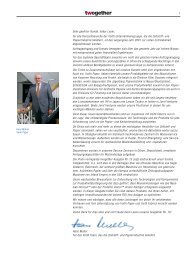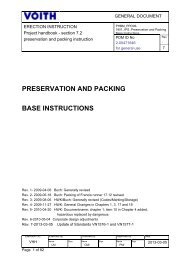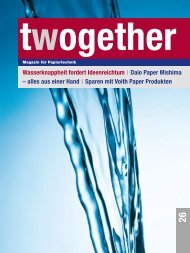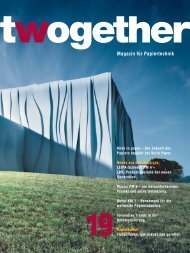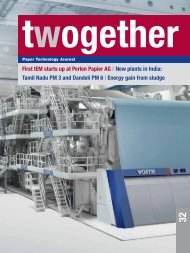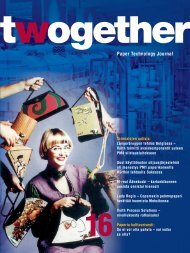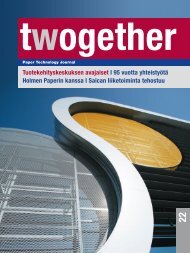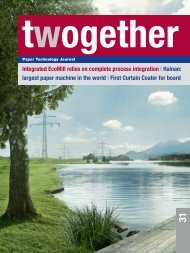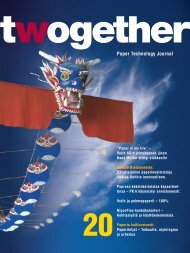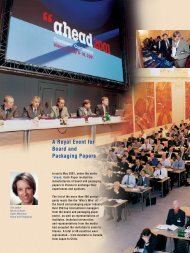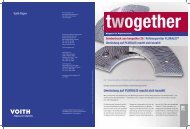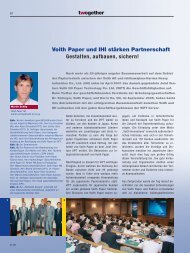Create successful ePaper yourself
Turn your PDF publications into a flip-book with our unique Google optimized e-Paper software.
The main reason why MTH continues to<br />
be used in pulp production in Indonesia<br />
is that the plantation establishment and<br />
development programmes introduced in<br />
the 1980s have failed to keep pace with<br />
the rapid development of the industry.<br />
Pulpwood demand has increased more<br />
rapidly than the wood supply from plantations,<br />
regardless of the plantation programmes<br />
that all major companies have<br />
been developing since the 1980s.<br />
Mixed Tropical Hardwood<br />
Mostly Used in Sawmilling and<br />
Plywood Manufacturing<br />
The estimated MTH volume used globally<br />
for pulp production is 13 million m3 , i.e.<br />
about 10 % of the total industrial use of<br />
tropical wood. The balance is processed<br />
into sawnwood and plywood, and used<br />
mainly in construction, joinery and furniture<br />
industries.<br />
Production of tropical logs in ITTO (International<br />
Tropical Timber Organization)<br />
producer countries, which include the<br />
great majority of tropical countries and<br />
forests, decreased to 121 million m3 in<br />
2002. Most of this wood (111 million m3 )<br />
was processed within ITTO producer<br />
countries and the balance (10 million m3 )<br />
was exported to other countries (mainly<br />
to Japan and the EU) for processing.<br />
Roughly two thirds (74 million m3 ) of the<br />
volume processed within ITTO countries<br />
was processed into sawnwood and one<br />
third (37 million m3 ) into plywood.<br />
Mixed Tropical Hardwood<br />
and Sustainability<br />
Indonesia’s plantation development programme<br />
was launched in the 1980s and<br />
became widely applied in the early 1990s,<br />
making Indonesia a leading plantation<br />
forest country in Southeast Asia. Industrial<br />
plantation forest concessions (called<br />
HTI concessions) with an area up to<br />
300,000 ha were granted to interested<br />
parties. The pulpwood concession areas<br />
consisted of different types of land and<br />
forest, from tropical forests, already degraded<br />
by selective cutting of plylogs and<br />
sawlogs, to open grasslands. Any larger<br />
unlogged virgin forests were left out from<br />
the pulpwood concessions and smallerscale<br />
undisturbed forests within the concessions<br />
were strictly protected, not allowing<br />
their conversion into plantations.<br />
As a result, most of the MTH pulpwood<br />
comes from conversion cuttings of degraded<br />
natural forests, which are mainly<br />
replanted by acacia and eucalypts.<br />
Typically, only 30-50 % of the granted<br />
gross concession area was suitable for<br />
plantation establishment. The balance included<br />
areas such as nature reserves, infrastructure<br />
areas and low-quality land<br />
unsuitable for planting. Since the 1980s,<br />
plantation development has been ham-<br />
Fig. 7: Pulpwood Demand Scenario in Indonesia.<br />
Million m3<br />
35<br />
30<br />
25<br />
20<br />
15<br />
10<br />
5<br />
Actual<br />
Scenario<br />
Plantation<br />
Pulpwood<br />
Supply<br />
MTH Harvest Requirement<br />
1990 1995 2000 2005 2010 2015<br />
5<br />
pered by many factors such as insufficient<br />
funding, land ownership disputes<br />
and forest fires, and there is a continuous<br />
challenge to intensify plantation development<br />
to keep pace with the industry’s<br />
capacity growth. Political changes in<br />
Indonesia have also put land-use issues<br />
high on the agenda, as local people have<br />
much more freedom and courage to<br />
speak for themselves than in Suharto’s<br />
time. These changes were not anticipated<br />
in formulating the HTI pulpwood concession<br />
policies and they have difficulties in<br />
coping with these changes.<br />
The first Indonesian pulp mill operating<br />
100 % based on plantation wood is already<br />
in operation (the Musi mill in<br />
Sumatra). The use of plantation wood is<br />
steadily increasing also in other mills.<br />
There are different scenarios concerning<br />
the future acacia pulpwood supply and<br />
MTH pulpwood requirement in Indonesia.<br />
The scenario presented in Fig. 7 is con-<br />
<strong>17</strong>/04<br />
7



